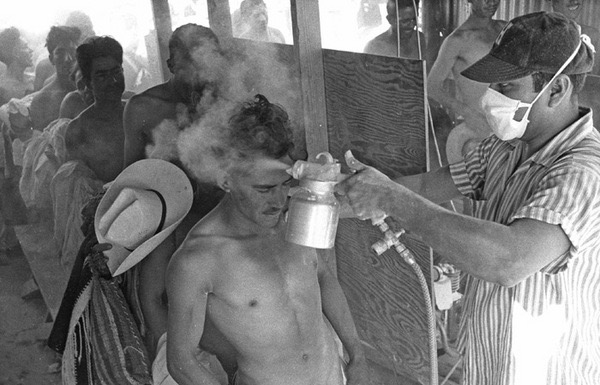
Associated Press (9/22/21): Farm bosses employing H-2A guestworkers harvesting in Florida and 3 other states “face charges of conspiracy under the RICO Act, conspiracy to commit forced labor, forced labor and conspiracy to obstruct proceedings before departments”;
Newest indictments underscore extreme vulnerability of temporary agricultural workers as H-2A program expands rapidly on farms across the country;
Lack of adequate oversight makes more cases of modern-day slavery inevitable without expansion of enforceable protections like those of the Fair Food Program.
Last week, federal authorities announced the indictment of three people — Bladimir Moreno, Christina Gamez, and Guadalupe Mendes Mendoza — by a grand jury in Tampa for their roles “in a multi-state conspiracy involving the forced labor of Mexican agricultural immigrants.” The news made headlines across the country. Here are the details, from an ABC News report:
Feds: 3 charged in Mexican migrant worker conspiracy
Three people have been indicted in a multi-state conspiracy involving the forced labor of Mexican agricultural immigrants
TAMPA, Fla. — Three people have been indicted in a multi-state conspiracy involving the forced labor of Mexican agricultural immigrants, federal authorities announced Wednesday.
A federal grand jury in Tampa formally charged Bladimir Moreno, Christina Gamez and Guadalupe Mendes Mendoza under a six-count indictment last week…
… According to the indictment, Moreno, Gamez and Mendes Mendoza ran a labor contracting company for migrant workers with temporary agricultural visas from 2015 through 2017. Los Villatoros Harvesting subjected multiple Mexican agricultural workers employed in Florida, Kentucky, Indiana, Georgia and North Carolina to forced labor, investigators said. The company also harbored migrant workers in the U.S. after their H-2A visas had expired for financial gain and committed visa fraud and fraud in foreign labor contracting, officials said.
Moreno and Gamez operated Los Villatoros Harvesting as a criminal scheme, prosecutors said. They’re accused of forcing workers to complete hundreds of hours of physically demanding agricultural labor through coercive means, such as imposing debts, confiscating passports, poor living conditions, verbal abuse and isolation, as well as threatening workers with arrest, deportation and physical harm… (read more)
Guestworkers: A history of exploitation and abuse
The H-2A, or “guestworker,” program is a federal program of temporary agricultural labor visas designed to address purported farm labor shortages by allowing agricultural employers to contract with foreign workers on a short-term basis. Its earliest incarnation, known as the Bracero Program, was launched in 1942 in response to labor shortages caused by the Second World War. The program was fraught with abuse, from racial discrimination to systemic wage theft, that resulted in widespread strikes, Congressional inquiries, and the termination of the program in 1964. For years, the term Bracero was synonymous with farm labor exploitation.

Today, guestworkers come to work in the US through the H-2A temporary visa program, which co-existed with the Bracero Program in the 1950’s but “employed guest workers on a much smaller scale, allowing the program to escape some of the criticism leveled at the Bracero Program.” With firm caps on the overall number of visas available to foreign workers, H-2A workers remained for decades the exception on farms in most states, with the supply of domestic workers historically sufficient to meet US farmers’ demand.
In recent years, however, the demand for guestworkers has increased significantly, driven in large part by the country’s inability to address the need for common sense immigration reform and increasing political attacks on immigrants. At the same time, the power dynamics that drove the wide scale exploitation of Braceros in the 1950s replicated themselves in the H-2A program, leading Representative Charles Rangel, former Chairman of the House Ways and Means Committee, to comment, “This guestworker program’s the closest thing I’ve ever seen to slavery.” The Southern Poverty Law Center issued its own report, which drew its title from Rep. Rangel’s quote, on the H-2A program in 2013 that began:
This report… details the systematic exploitation of foreign workers who come to this country for temporary jobs under the nation’s H-2 guestworker program. Based on dozens of legal cases and interviews with thousands of guestworkers, it documents how guestworkers are routinely cheated out of wages, forced to mortgage their futures to obtain low-wage, temporary jobs, and held virtually captive by employers.
Most recently, a report titled “Labor Exploitation and Trafficking of Agricultural Workers During the Pandemic” analyzed data from the National Human Trafficking Hotline and concluded that labor conditions for farmworkers in the guestworker program have deteriorated significantly since the COVID-19 outbreak. The report, released by the anti-trafficking organization Polaris, concluded that:
Migrant workers, including those in the United States legally on H-2A, H-2B, and other temporary work visas, routinely face situations of financial exploitation, threats, and unsafe living and working conditions at the hands of their employers. As the data from the U.S. National Human Trafficking Hotline illustrates, the COVID-19 pandemic has exacerbated the systemic problems that are inherent in the temporary visa system that leave migrant workers vulnerable to trafficking and exploitation… (read more)
Specifically, the report found that “agriculture workers with H-2A visas reported 70% more cases of trafficking and exploitation during the pandemic and at least one-third of workers also reported being denied medical attention, among other abuses…”
Power dynamics drive exploitation of guestworkers, demand effective labor rights monitoring and enforcement
The widespread and deepening exploitation of guestworkers is rooted in two central elements of the guestworker experience: 1) the fact that workers often incur significant debts to unscrupulous, and often violent, recruiters, during the recruitment process in their home countries, with the safety of their families serving as collateral during their time abroad, and, 2) the fact that, once here, guestworkers are unable to change employers, as their legal status in the US is tied to their employment. Both of these facts result in deep and abiding dynamics of control and subjugation, leaving guestworkers unwilling to complain about abuse for fear of losing their jobs, at best, or, at worst, losing their families back home.
Given these inherent power imbalances between guestworkers and their employers in the H-2A program, it is essential that guestworkers receive particular attention from labor advocates and government labor monitors. Unfortunately, the opposite is true. Despite the successful efforts of the dedicated public servants behind the investigation at the top of this post, the operation uncovered in that investigation represents only the very tip of the iceberg of guestworker recruitment and labor abuse. As the SPLC and Polaris reports make clear, the vast majority of guestworker exploitation goes unreported, and the situation is only getting worse: the H-2A program continues to rapidly expand, and the pandemic only exacerbates the isolation of guestworkers from the rest of US society, including the government investigators responsible for their safety.
That’s why it is more urgent than ever that the Fair Food Program, with its unique monitoring and enforcement powers, also continue to expand. Indeed, the FFP is uniquely suited to address the structural problems at the heart of guestworker exploitation, with a clean recruitment channel in Mexico and wall-to-wall monitoring, 24/7 trilingual complaint mechanism, and worker education and empowerment here in the US, all backed by the market power of the program’s Participating Buyers.
The documented history of worker abuse in the guestworker program, the worsening of that abuse in recent years, and last week’s announcement of the most recent forced labor prosecution should provide more than enough motivation for ethical food retailers to secure their own supply chains by bringing in the industry-leading standards and enforcement powers of the Fair Food Program. Companies like Wendy’s, Kroger, and Costco are on notice: they have the power to help curb, if not end altogether, the rampant exploitation of guestworkers in the food industry. Instead of living on tenterhooks about when the next shocking headline might emerge from their supply chains, they could join the 14 other multi-billion dollar retail food giants that have put their trust in the Fair Food Program as the most effective risk prevention program in the food industry today.
If the past is indeed prologue, however, what they do next will be sadly all too predictable.

